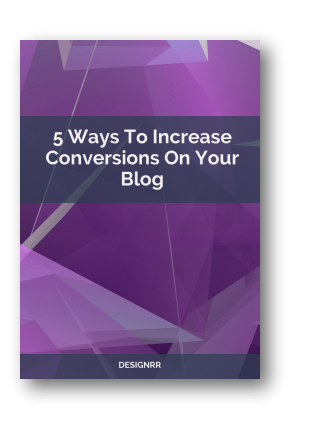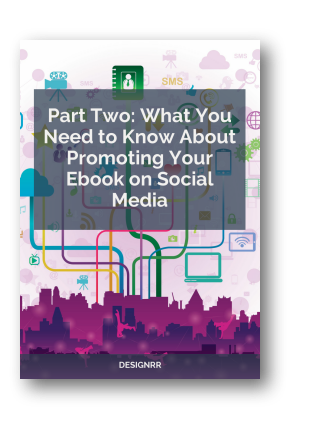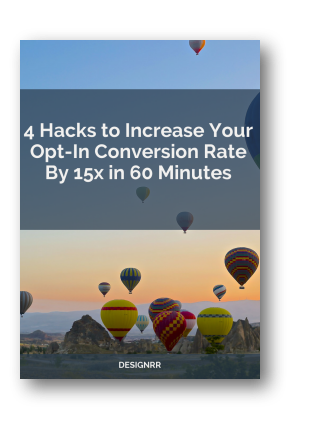Writing an eBook can be challenging. You need to come up with ideas, do research, put your thoughts down on paper (or screen!), and edit your work until it shines. Thankfully, AI writing tools offer a helping hand to make the process faster and easier. In this article, we’ll explore some of the best AI writing tools on the market, focusing on those that can help you craft a fantastic eBook.
What are AI Writing Tools?
AI writing tools are software programs that use advanced language models to help you write better and faster. Think of them as a super-smart writing assistant that’s always available to lend a hand. These tools can do many things,
How AI Elevates Your eBook Creation

Let’s delve into specific ways AI writing tools streamline the journey from your initial concept to a refined, reader-ready eBook:
- Generate ideas and outlines: Struggling with writer’s block? AI tools can brainstorm topics, suggest chapter structures, and even create initial outlines for your eBook.
- Write drafts: Some AI tools can write entire sections of text based on your input. This can be a great way to get a “first draft” down quickly.
- Improve your writing: AI tools can spot grammar errors, suggest better phrasing, and help you write more clearly and concisely. Think of it as a tireless editor!
- Research and gather information: Need facts and figures? Some AI tools can pull relevant information from the web, saving you valuable research time.
Why You Might Not Want to Use AI Writing Tools
It’s important to remember that AI writing tools are still evolving, and there are some reasons why they might not be the right fit for every author or project:
- Lack of originality: AI tools are trained on existing data. While they can produce well-written content, it can sometimes lack the unique and fresh perspective you bring as the author.
- Potential for errors: Even the best AI tools can make mistakes, especially with factual information or complex topics. It’s crucial to always proofread and fact-check carefully.
- Loss of personal touch: Your writing style is part of what makes your eBook distinctive. Over-reliance on AI tools can make your writing feel generic and less engaging.
- Ethical concerns: Some argue that AI-generated content can raise issues around plagiarism and originality.
Note: It’s essential to use AI writing tools responsibly and transparently. They should be seen as a powerful assistant, not a complete replacement for your own creativity and expertise.
Best AI Writing Tools You Can Use to Create Your eBook
1. Designrr.io
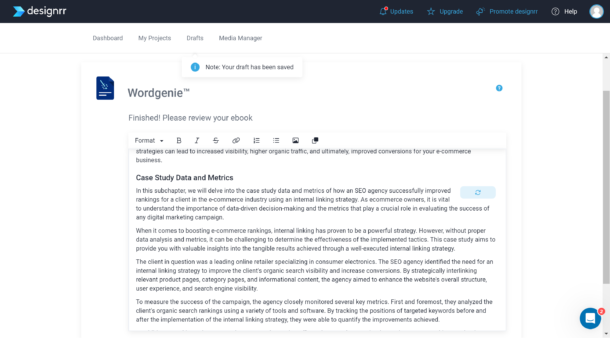
Designrr.io stands apart with its unique blend of AI-powered content creation (through Wordgenie integration) and streamlined eBook design capabilities. Its chat-like editing interface adds a touch of convenience and interactivity to the writing process.
- Strengths: This platform significantly simplifies the eBook creation experience, allowing you to write, edit, and format your work within a single environment. The ability to import existing content, such as blog posts, and quickly transform them into an eBook format is a major time-saver.
- Best for: Authors wanting an efficient all-in-one solution to create and design their eBook without switching between multiple programs. If you prioritize speed and ease of use, Designrr.io’s integrated approach is incredibly appealing.
- Considerations: For authors seeking absolute granular design control, Designrr.io might not fully replace dedicated design software which offer more extensive customization.
Read more about Designrr’s ebook creator
Read more about the best ebook software to use
See Designrr’s special offer today!
2. Jasper.ai
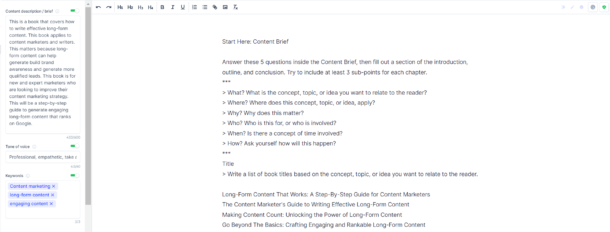
Jasper.ai is considered a leader in the AI writing space, particularly for its ability to generate well-researched and informative content. It leverages sophisticated language models and offers a vast library of templates tailored to different writing tasks and eBook sections. You’ll also find tools for creating marketing and sales copy, and even translating your work into other languages.
- Strengths: Jasper.ai shines when handling factual topics, providing thorough research assistance and ensuring the accuracy of your content. Its ability to write marketing materials makes it a valuable asset for authors focused on promoting their finished eBook.
- Best for: Authors dedicated to creating comprehensive non-fiction eBooks with well-supported information. Marketers and writers who need to generate sales-oriented content alongside their core eBook will also appreciate Jasper.ai’s versatility.
- Considerations: While it excels with factual content, Jasper.ai might be less ideal for those solely focused on creative fiction writing where a spark of originality is key. Additionally, its pricing plans can be a bit higher compared to several other options on the market.
3. Rytr

This budget-friendly assistant shines in crafting a wide variety of content types. Its ability to switch writing styles makes it a valuable asset in your author’s toolkit, especially if you want to inject humor, formality, or inspiration at different parts of your ebook.
- Strengths: Generous free plan and budget-friendly pricing tiers. Rytr offers a selection of templates for various content forms. Change its writing style to match the feel of your eBook (e.g., persuasive, humorous, or informative).
- Best for: Authors seeking a cost-effective AI writing companion to tackle different parts of the eBook creation and promotion process.
- Considerations: For heavily research-based writing or purely creative fiction, more specialized tools might offer greater depth.
4. ShortlyAI

ShortlyAI focuses on collaborative, creative writing. Instead of traditional templates, it uses a command-based system where you guide the AI’s direction, enabling the writer to retain more control. This makes it particularly well-suited for fiction writing.
- Strengths: ShortlyAI’s strength lies in sparking creativity for fiction authors. It can assist with building scenes, fleshing out characters through description or dialogue, and overcoming writer’s block in general.
- Best for: Fiction writers seeking inspiration or needing help with specific narrative elements to enhance their storytelling. If your eBook leans towards novels and imaginative works, ShortlyAI’s unique approach could be valuable.
- Considerations: For heavily researched or factual writing, ShortlyAI is less ideal. Mastering its command system also takes some practice, but the potential rewards for fiction writers are significant.
5. Writesonic

Writesonic promotes itself as a versatile writing tool capable of generating everything from marketing copy to different eBook components. Additionally, it boasts SEO integration with tools like Semrush, aiming to boost your content’s discoverability.
- Strengths: Writesonic offers templates for various stages of the eBook creation process, from drafting introductions and outlines to even crafting potential marketing materials. Its focus on SEO could prove beneficial for authors concerned with online visibility.
- Best for: Authors wanting a tool that assists across multiple eBook-related tasks, from writing content to improving search engine rankings. The included SEO features add unique value to this platform.
- Considerations: The emphasis on versatility might mean that Writesonic lacks the depth of some niche-specific tools. If your eBook requires extensive research or relies on complex technical information, other options may be more suitable.
6. Grammarly

Grammarly is a widely used AI-powered writing assistant specializing in grammar, punctuation, and style corrections. It also offers suggestions for clarity, conciseness, vocabulary improvement, and even tone adjustments. While not strictly a content generator, it’s an essential tool for polishing your eBook’s writing.
- Strengths: Grammarly excels at catching errors that human eyes might miss, ensuring your final eBook reflects professionalism. Its suggestions can enhance your writing style and ensure you’re effectively communicating ideas.
- Best for: All authors. Whether writing fiction or non-fiction, Grammarly provides an invaluable safety net to produce a well-written and error-free eBook. It’s especially important if English is not your native language.
- Considerations: Grammarly is a refining tool, not a replacement for your own careful proofreading and knowledge of grammar rules. It’s best used in conjunction with other AI writing tools or your own writing process.
Read more: Best proofreading softwares
7. Sudowrite
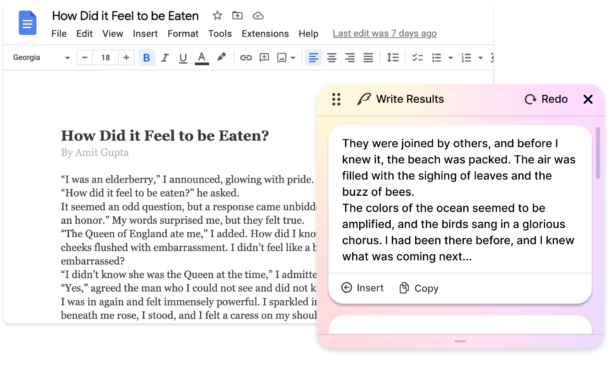
Sudowrite specifically caters to fiction authors, offering a range of tools that focus on creative writing elements. It includes features to help you brainstorm, expand your worldbuilding, refine your descriptions, and even overcome writer’s block.
- Strengths: Sudowrite excels at sparking inspiration and helping you craft compelling narratives. Its unique features, like character development suggestions and plot twist generators, add a touch of magic to the creative writing process.
- Best for: Authors writing novels, short stories, screenplays, or any creative fiction-based eBook. Sudowrite helps you tap into your creativity and build your fictional world more effectively.
- Considerations: Sudowrite won’t replace your own storytelling skills, but provides an excellent springboard and a source of fresh ideas. If you’re not focused on fiction writing, then its specialized features won’t be as useful.
Picking Your Perfect AI Partner: A Strategic Guide for Crafting Your eBook
Choosing the right AI writing tool for your eBook can be the difference between a smooth, productive writing experience and a frustrating roadblock. Here’s how to ensure you select the ideal AI co-pilot for your project:
1. Deep Dive into Your Needs:
- Overcoming writer’s block and seeking creative sparks: Consider tools with a strong fiction focus like Sudowrite or ShortlyAI. Their features for brainstorming, character development, and adding surprise twists can fuel your creative process.
- Needing robust research support and informative writing: Jasper.ai excels in these areas, leveraging advanced language models and offering reliable factual assistance.
- Prioritizing versatility and affordability: Writesonic handles multiple content types decently and offers an accessible free plan, making it a great starting point.
- Aiming to design and write your eBook within a single platform: Look no further than Designrr.io with its AI-driven writing and streamlined eBook formatting.
2. Feature Focus: Go Beyond Marketing Hype
- Explore template libraries: Ensure the available templates align with your genre and the type of content you need help creating (introductions, outlines, chapters, marketing materials).
- Evaluate unique strengths: Consider tools with SEO integration like Frase.io or Outranking.io if boosting search engine visibility is a priority.
- Don’t forget the finishing touches: Remember that Grammarly is an invaluable tool for polishing your writing and ensuring a grammatically sound and well-structured eBook.
3. User-Friendliness: Finding Your Comfort Zone
- Free trials are your friend: Test out different tools to see what feels intuitive. For example, try ShortlyAI’s command-based system versus the pre-built templates provided by Jasper.ai or Rytr.
- Interface matters!: A clean, user-friendly interface is essential to maximize productivity and keep you motivated.
4. Budget Considerations: Finding the Right Fit
- Start with free plans: Rytr has a generous free option, allowing you to experiment and assess its value.
- Match features to cost: Evaluate pricing tiers and ensure you’re paying for features that bring the most value to your specific eBook project.
Workflow Integration: Building a Productive Partnership
Here’s how to create a workflow that effectively combines AI tools with your current writing process:
1. Identify Your Workflow Stages
Break down your writing process into steps. For example:
- Brainstorming & Ideation
- Research and Information Gathering
- Outlining
- Drafting & Content Generation
- Editing & Revision
- Proofreading
2. Match AI Tools to Workflow Stages
Analyze which tools fit best into each stage. Here’s how our previously discussed tools might slot in:
- Brainstorming & Ideation: Sudowrite, ShortlyAI, Jasper.ai (Idea generation templates)
- Research & Information Gathering: Jasper.ai, Frase.io, Outranking.io
- Outlining: Jasper.ai, Rytr, Designrr.io
- Drafting & Content Generation: Writesonic, Jasper.ai, ShortlyAI, Designrr.io
- Editing & Revision: Jasper.ai, Rytr, Designrr.io, Grammarly
- Proofreading: Grammarly
3. Start Small, Build Gradually
Don’t feel the need to overhaul your entire process at once. Experiment with one AI tool at a time, seeing where it provides the most value. For instance, you might start with using Grammarly as a final polishing step, and then incorporate an AI tool like Jasper.ai to assist with specific chapters or sections where you need additional research support.
4. Maintain a Human Touch
Remember, AI tools are assistants. Regularly step back, reread your work with a critical eye, and ensure the writing still reflects your unique voice and style.
Practical Tips
- Utilize document sharing: Many AI tools allow importing and exporting, ensuring easy integration with your word processor or content management system.
- Leverage custom templates: Some tools like Rytr and Jasper.ai let you create customized templates aligned with your specific eBook format and needs, further streamlining your workflow.
Example: Enhancing a Non-fiction eBook Workflow

Jumpstart with Wordgenie:
- Begin by entering your niche (e.g., “Snowboarding”) and target audience (e.g., “Teenagers”) into Designrr.io’s Wordgenie.
- Utilize Wordgenie to brainstorm potential titles and generate an initial eBook outline, refining it as needed with the “regenerate” option (use credits wisely!).
- Leverage Wordgenie to create a base of content for your key chapters, customizing and expanding upon it further with your expertise.
Research:
- For in-depth research and fact-checking, use tools like Jasper.ai to supplement the foundation laid by Designrr.io.
Outlining:
- If you need further outlining assistance beyond Wordgenie’s initial output, Jasper.ai’s outlining templates can help enhance your eBook’s structure.

Drafting & Editing:
- Draft your content, drawing from Wordgenie’s output, Jasper.ai’s research assistance, and your subject matter knowledge.
- Take advantage of Designrr.io’s built-in editing tools for revisions, as well as its unique chat interface for on-the-fly content generation and modifications.
- Employ Rytr as needed to adjust the tone of specific sections and ensure readability.
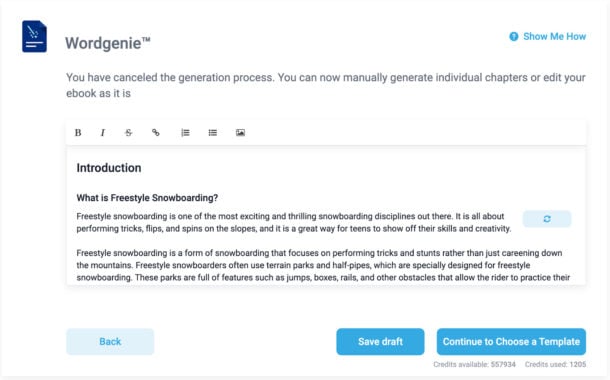
- Proofreading: Finalize your eBook with a thorough proofread using Grammarly.
Benefits of this Workflow:
- Efficient Kickstart: Designrr.io and Wordgenie provide a rapid starting point, especially if you struggle with outlining or initial drafts.
- Streamlined Workflow: Designrr.io’s integrated writing and formatting tools minimize the need to switch between multiple platforms.
- Focused Collaboration: Use Jasper.ai to tackle complex research tasks, complementing Wordgenie’s content generation capabilities.
Important Notes:
- Wordgenie Credits: Remain mindful of credit usage within Wordgenie. Plan your regenerations strategically to avoid depletion while drafting content.
- Your Unique Touch: Remember, AI tools are meant to assist, not replace your creativity! Always add your voice, insights, and expertise to make the eBook uniquely yours.
Cut your eBook writing time with AI help! Check out Designrr’s special offer today.
A Balanced Perspective
AI writing tools are undeniably helpful, particularly when it comes to streamlining routine tasks and getting past writer’s block. However, it’s important to be mindful of their limitations. While they can produce well-written text, replicating that spark of human originality–the unexpected turn of phrase, the clever humor–is where AI may fall short. Remember, these tools are best used strategically, not as a full replacement for your own creative voice.
Key Takeaway
Think of AI writing tools as powerful additions to your writing toolkit. They offer a foundation for ideas, help structure complex information, and refine your prose. The real magic happens when you leverage the assistance of the AI alongside your unique creativity and subject matter expertise. By embracing this collaboration, you’ll unlock a workflow that pushes boundaries, allowing you to craft an eBook that’s distinctively your own.

